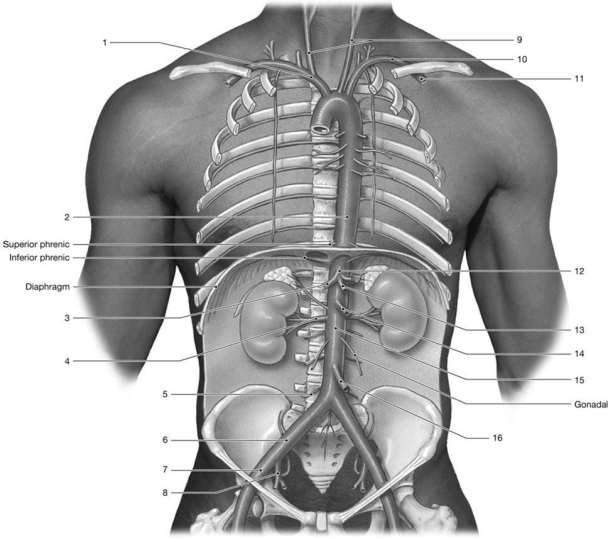A) vascular resistance
B) peripheral veins have valves to prevent backflow of blood
C) muscular pumps squeeze veins and move blood toward the heart
D) blood pressure
E) blood pressure gradient from arteries to veins
Correct Answer

verified
Correct Answer
verified
Multiple Choice
The ________ receives blood from the diaphragm.
A) pleural vein
B) phrenic vein
C) inferior vena cava
D) celiac trunk
E) inferior mesenteric vein
Correct Answer

verified
Correct Answer
verified
Multiple Choice
Partial constriction due to constant sympathetic stimulation of blood vessels is known as
A) vasoconstriction.
B) vasodilation.
C) arteriosclerosis.
D) vasomotor tone.
E) aortic reflex.
Correct Answer

verified
Correct Answer
verified
Multiple Choice
What structure do RBCs move through single-file?
A) artery
B) arteriole
C) capillary
D) venule
E) vein
Correct Answer

verified
C
Correct Answer
verified
Multiple Choice
Figure 21-1 Arteries
 Use Figure 21-1 to answer the following questions:
-Identify the arteries labeled "9."
Use Figure 21-1 to answer the following questions:
-Identify the arteries labeled "9."
A) axillary
B) brachiocephalic
C) common carotid
D) aorta
E) brachial
Correct Answer

verified
Correct Answer
verified
Multiple Choice
Veins from the spleen, pancreas, and lateral border of the stomach unite to form the
A) celiac trunk.
B) hepatic portal vein.
C) splenic vein.
D) gastric vein.
E) superior mesenteric vein.
Correct Answer

verified
C
Correct Answer
verified
Multiple Choice
Blood flow to a tissue will increase if the
A) level of oxygen at the tissue increases.
B) level of carbon dioxide at the tissue decreases.
C) veins constrict.
D) arterioles dilate.
E) arterioles constrict.
Correct Answer

verified
Correct Answer
verified
Multiple Choice
The difference between the systolic and diastolic pressures is called the ________ pressure.
A) critical closing
B) mean arterial
C) pulse
D) blood
E) circulatory
Correct Answer

verified
Correct Answer
verified
Multiple Choice
Figure 21-1 Arteries
 Use Figure 21-1 to answer the following questions:
-Identify the artery labeled "16."
Use Figure 21-1 to answer the following questions:
-Identify the artery labeled "16."
A) axillary
B) inferior mesenteric
C) celiac
D) superior mesenteric
E) splenic
Correct Answer

verified
Correct Answer
verified
Multiple Choice
The bronchial arteries branch from the ________ to supply the lung airways.
A) pulmonary arteries
B) thoracic aorta
C) pulmonary veins
D) pleural arteries
E) brachiocephalic trunk
Correct Answer

verified
Correct Answer
verified
Multiple Choice
The blood vessel that supplies blood to the muscles and other tissues of the neck, shoulder, and upperback is the
A) brachiocephalic trunk.
B) common carotid artery.
C) jugular vein.
D) thyrocervical trunk.
E) axillary artery.
Correct Answer

verified
Correct Answer
verified
Multiple Choice
Points where a muscular artery can be compressed against a bone to control severe bleeding are called
A) decompression points.
B) palpation points.
C) diastolic points.
D) regulation points.
E) pressure points.
Correct Answer

verified
Correct Answer
verified
Multiple Choice
When carotid and aortic baroreceptors reduce their output,
A) heart rate increases.
B) heart rate decreases.
C) stroke volume increases.
D) both heart rate and stroke volume increase.
E) the heart rate will decrease to lower blood pressure.
Correct Answer

verified
D
Correct Answer
verified
Multiple Choice
________ is a bulge, or weakened wall, of an artery.
A) aneurysm
B) stroke
C) vascular edema
D) arteriosclerosis
E) atherosclerosis
Correct Answer

verified
Correct Answer
verified
Multiple Choice
Blood moves forward through veins because of all of the following except
A) the pressure in the veins is lower than in the arteries.
B) pumping by the smooth muscle in the wall of the vein.
C) the respiratory pump.
D) valves in the veins preventing the backward flow of blood.
E) muscular compression.
Correct Answer

verified
Correct Answer
verified
Multiple Choice
During hemorrhaging, the drop in capillary hydrostatic pressure will ________ NFP, thus ________ reabsorption.
A) increase; reducing
B) increase; increasing
C) decrease; reducing
D) decrease; increasing
E) stabilize; reducing
Correct Answer

verified
Correct Answer
verified
Multiple Choice
Each of the following will cause an increase in blood pressure except
A) increased levels of aldosterone.
B) increased levels of angiotensin II.
C) increased blood volume.
D) increased levels of ANP (atrial natriuretic peptide) .
E) increased levels of ADH (antidiuretic hormone) .
Correct Answer

verified
Correct Answer
verified
Multiple Choice
Which of the following is a deep vein of the forearm?
A) azygos
B) hemiazygos
C) cephalic
D) radial
E) basilic
Correct Answer

verified
Correct Answer
verified
Multiple Choice
The ________ carries nutrient-rich blood into the liver.
A) hepatic artery
B) gastric vein
C) myenteric capillaries
D) hepatic portal vein
E) superior mesenteric vein
Correct Answer

verified
Correct Answer
verified
Multiple Choice
Which of the following is true of capillaries compared to other vessels?
A) Blood pressure and velocity are highest.
B) Blood pressure and cross-sectional area are lowest.
C) Cross-sectional area is highest and velocity is lowest.
D) Cross-sectional area is lowest and velocity is highest.
E) Blood pressure is highest and velocity is lowest.
Correct Answer

verified
Correct Answer
verified
Showing 1 - 20 of 225
Related Exams